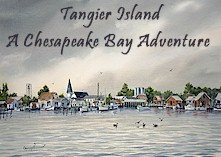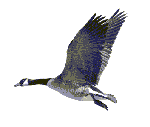Tangier Island Guide
Tangier Island: A Chesapeake Bay Island
Tangier Island Bed and Breakfasts,
Tangier Island Transportation, Tangier Island Cruises, Sunset Tours, Eco
Tours, Restaurants, History, and more......
Tangier
Island
Water
Trails

Tangier
Island Transportation
Joyce
Marie II - Onancock, Virginia
Steven
Thomas, Crisfield, Md
Chesapeake
Breeze, Reedville, Va.
Chesapeake
Bay Eagle Crisfield Md
Sharon
Kay III, Crisfield, Md.
Tangier
Island Restaurants
Hilda
Crockett's Chesapeake House
Fishermans
Corner
Lorraine's
on Tangier
Waterfront
Restaurant
Tangier
Island Bed and Breakfasts
Aunt
Ruth's Place - Vacation Rental
Hilda
Crockett's
Chesapeake
House BB
Bay
View Inn Bed and Breakfast
Sunset
Inn Bed and Breakfast
Tangier
Island - Parks Marina
Tangier
Island Buggy Tours
Chesapeake
Bay Crab Shanky
Adventures
Tangier
Island Eco Tours, Sunset Tours, Crabbing, or
Southern
Living Magazine - May 2005
Tangier
Island Recipes
Tangier
Island Real Estate

For Your Convenience
Eastern Shore of Virginia
Real Estate
Mason-Davis,
Weichert Realtors

Bike
Rentals provided by the Waterfront Restaurant
Tangier
Island Tours provided by the Hilda Crockett's Chesapeake House
Golf
Cart Rentals offered by
the
Sunset Inn Bed and Breakfast

Visit us again
soon for additional information on Tangier Island, until then contact us
direct for information regarding Tangier Island: Transportation to the
island, Tangier Island Bed and Breakfasts - Accommodations and Lodging,
Restaurants, Eco Tours, Tangier Island Sunset Tours, anything in general,
Click
Here.
Chesapeake
Bay Charter Fishing, Sunset Cruises, Outdoor Adventures
Upon arriving on Tangier Island, enjoy
an afternoon of days gone by............
Return to Top
|
|
Tangier Island
History
In the summer of
1608 John Smith started out on an exploration trip of the
Chesapeake Bay. He traveled from Cape Charles and went up the bay to the
Potomac River and went up as far as present day Washington D. C. and back
down to Jamestown. It was actually two trips for at one point he was very
badly
hurt by a stingray and had to return to Jamestown to be treated. It was
during
these two voyages, while looking for fresh water that he came across a
group of
islands in the middle of the bay. He named them the "Russell Isles," for
a Doctor
Russell who was then on board ship with him.
This group is today what is known as Smiths, Tangier and Watts Islands.
Tangier Island is about 6 miles below the Maryland-Virginia State line
and at one
point all the islands below the state line were known as the "Tangier Islands"
in
Virginia’s records. These, among others, included Shanks, Old Walnut Island,
Piney Island, Queen’s Ridge, Horse Hummock, South Point, and Hog Neck.
The
latter three being attached to the lower part of Smith’s Island in Maryland.
The
"s" was probably lost sometime after 1880 when erosion took its toll on
these
islands and the inhabitants moved to Crisfield MD, Onancock Va or Tangier
Island itself. At that time what we now know as Tangier
Island consisted of six
ridges or long narrow areas of land rising slightly above the marsh of
which
three are inhabited today. Main Ridge is today the center of town. The
old
church was in the same location as the present one on the northern end
of this
ridge and the land south of it was called "The Field." At one time it was
planted
with corn. Canton is the ridge just to the east of Main Ridge and is connected
by
a bridge. It was on this ridge the first settlement was made and for a
while was
more populated that Main Ridge. It is generally believed that the homes
of the
early fishermen were here while the other ridges were used for farming.
West
Ridge is about a mile long. In recent times a sea wall was erected and
it has a
small airport or airpark on it.
Oyster Creek Ridge or what remains of this has long been abandoned. Joshua
Thomas’ son, John ran the first store on the island here. Canaan or "The
Up’ards" is about a mile and a half above the others and although at one
time it
was connected to Main Ridge by a roadway it became unreachable by land
around 1923 and has not been inhabited since 1928. East Point Ridge was
a
very small ridge to the northeast of Canton. It was abandoned in approximately
1905, shortly after the houses on it burned.
In 1670 Ambrose White received a patent for 400 acres called an Island
in the
Chesapeake Bay. the next year White assigned his patent to Charles and
John
West. In 1673 William Walton was granted 400 acres on the western island
which
was formerly patented by White. There is a similar entry in the patent
book three
years later but Scarburgh and West were the recipients instead of Walton
and in
1678 a formal patent was issued to both of them. Charles Scarburgh left
his
interest to his wife Elizabeth in 1702 and John West’s interest went to
his eldest
son a year later. In 1713 two patents were granted to Elizabeth Scarburgh
and
Anthony West for Tangier Islands. One was for 900 acres which included
the
original 400 acres and 500 acres more found within its bounds. The other
grant
was for 170 acres of new land south of Tangier called "Sandy Beach Island"
which was probably the hook shaped part that is now attached to the main
of
the island. This was the first time Tangier Islands was named in the records.
Although Elizabeth Scarburgh left her interest to her daughters, some how
the
title went to her oldest son, Bennett. It then passed to Henry Scarburgh
and then
to a Charles Scarburgh. In 1762 Charles Scarburgh confirmed an undeeded
sale
of his half to Colonel Thomas Hall. The next year Hall sold this to William
Andrews as 475 acres.
Tradition states that Tangier was first settled by a John Crockett and
his eight
sons in 1686, who had come to the island to tend cattle, but nothing has
been
found to verify this. The first Crockett of record on Tangier was Joseph,
the son
of Sampson and the grandson of John Tyler of Smith’s Island MD. It was
this
Joseph who bought 475 acres of the Andrews land in 1778. It does not seem
likely that Joseph tended cattle at all for he was left a inheritance by
his
grandfather John Tyler, was bound to his uncle Thomas Tyler to be a weaver
and learn his numbers, lived on Smith’s Island MD with his uncle until
about
1744, was made constable of "Tangier Islands" in 1763 and was given all
of
"South Point" by John Fish in his will of 4 April 1765. It was not likely
that a man
of some means would be tending cattle. By 1799 the West part of the patent
had
descended down to a John West who in this year left his interest to his
son
Anthony, who was to complete an unrecorded deed for 100 acres to Joseph’s
son John and the remainder was to be sold. Joshua Thomas, who was raised
on Smith’s Island, living with his cousin David Tyler there and had married
Rachel Evans, the daughter of Richard, bought 75 acres of it.
The 1800 census of Accomack County showed that there were 79 people on
the
"Tangier Islands," most of which were Crocketts or descendants of Crocketts.
Farming was their chief occupation. By 1880 the population was 589 and
by
1900 there were 1064 inhabitants. The population increased slowly between
1800 and 1850, and then rapidly until 1900.
In 1805 an event happened that had a great impact on the life on Tangier,
the
Chesapeake Bay and Joshua Thomas in general. The number of Methodist
followers had been growing since the close of the Revolutionary War and
Joshua Thomas was hired to carry some people to a Methodist camp meeting
on Pungoteague Creek. While there, he heard Lorenzo Dow, a very powerful
preacher speak and he along with others were converted. On arriving home
he
arranged for a meeting to be called. And, so, the Methodist Church was
established on Tangier. The small Methodist society, led by Thomas until
he
moved to Deal’s Island MD met in homes until 1835 when the first church
was
built. A list of members in 1825 includes: Henry Crockett and Sally Crockett,
Priscilla Crockett, a widow, Zachariah and Polly Crockett, Daniel and Esther
Dise, Rhoda Parks, Babel and Nancy Paul, George and Leah Pruitt, John and
Elizabeth Thomas, and John and Anna Thomas. The church grew and
prospered and in 1856 the first Sunday school was established by Henry
Crockett and Kathryn Sturgis; children and adults attended.
The War of 1812 did not have much effect on Tangier Island until 1813 when
the
British extended their excursions up the Chesapeake Bay. By March of that
year
the British had traveled up the Bay for about 180 miles. shortly after,
they arrived
on Tangier Island. They had set up a number of water wells on the beach
and
built several houses. They threw up breastworks and mounted a cannon on
the
south end of the island adjacent to Joshua Thomas’ camp meeting grove and
also had plans to erect a hospital when summer came. At one point, about
1200
British soldiers must have been on the island. In Summer of 1813, the British
disembarked for their attack on Baltimore from Tangier Island. The commanding
officer asked Joshua Thomas to speak before they left and his sermon warned
of defeat.
There have been four epidemics on Tangier. First, in 1866, came Asian cholera.
Along with this epidemic came a religious revival with repenting and praying
when the people started to die. Bodies were quickly buried, many of them
in
their front yard and without stones, for there was as many as five adults
dying at
a time. Both the Death Records of Accomack County and the dates on the
graves with stones show that the island was hardest hit in the month of
October.
In the early 1870’s there was both tuberculosis and a measles epidemic
and in
the 1880’s there was smallpox.
Besides sickness, the weather can be and was harsh at times. There have
been
many tropical storms and hurricanes to hit the island. One such storm in
1821
"The September Gust" swept over the island leaving great destruction. The
winters can also be especially hard. Almost once a year the Bay freezes
making
travel to the mainland impossible for a few days and at least once a century
the
freeze is so great that people walked on the ice to get supplies. Today
supplies
are flown in.
With the advent of the seafood market in the 1840’s the Chesapeake Bay
became alive with sailing ships that carried oysters and later crabs to
major
cities such as Baltimore and New York. The people gradually stopped
harvesting the land and harvested the waters. With the coming of the railroad
to
Crisfield MD, their water crop could be shipped farther and oystering and
crabbing became their main livelihood. Tangier Island today is a mixture
of old
and new. The people still follow the water, and along with Smith’s Island
MD,
other bayside communities, supply a great amount of the nation’s seafood.
The
majority of the people still follow the Methodist Religion that Joshua
Thomas
brought to the Island in 1805. And, today, like in 1800 the population
is mainly
Crocketts and descendants of Crocketts. Return to Top
History Document
used by exclusive permission of: Gail M. Walczyk,
Peter's Row, 27 Thomas St.,
Coram, NY
|




